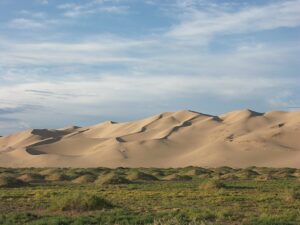Mongolian cuisine predominantly consists of meat, dairy, and seasonal fruits and vegetables. Mongolians have a long tradition of adjusting their food depending on the four seasons, the time of day, the person’s gender and age, etc, the type and amount of food have been adjusted.
Here are the top 5 must-try foods in Mongolia.
Boodog
Boodog is a real Mongolian traditional dish, In order to cook boodog it’s mostly using a goat or Mongolian marmot. Imagine you are in the 13th century and you don’t have fancy kitchen facilities that bring all comfort for cooking. Apparently, Mongols did not need almost any kitchen facilities to cook a delicious meal. To cook boodog animal whole skin will be used as a bag or vessel and internal organs, body parts, and intestines will be removed and seasoned with salt and vegetables mostly potato, carrot, and onions.
After the removal of internal parts, incandescent rocks will be inserted back into the skin bag along with all the removed parts such as organs, seasoned meat, and vegetables. After all necessary ingredients are placed into the skin bag and tied tightly by iron wire, the fur of the animal will be roasted by the fire and most importantly skin must remain intact during the process of removing and roasting.
Boodog may seem bizarre or unusual to foreigners but let us assure you it’s a very organic and mouth-watering dish.
Mongolian tea
You may wonder why tea is being considered a must-try food in Mongolia.
Mongolians have been cooking tea in various methods by millennium to cure diseases, relieve fatigue and improve overall physical strength. Each region and ethnicity of Mongolia has it is own special tea. Compare to teas in other countries Mongolian tea is almost like a soup because it is served with other ingredients like milk, rice, meat, or even a sheep tail which makes it soup rather than tea.
Below are the most popular types of teas in Mongolia
- Butter ladled tea: In a large bucket, mix the fresh butter with a pinch of salt and dilute with hot tea, stir well, pour on regular black tea, ladle well and boil over low heat.
- Sheep tail tea: Steam and smash Steam thinly sliced sheep tail and dry tea leaf and grind well. Pour milk and a well-ground tea leaf with a sheep tail into hot water. Put some salt and boil for 30 to 35 minutes and ladle well.
- Nettle tea: Nettle would be pickled and dried in May-June when there are 5-6 saplings. Dried nettles have to be ground, fried in oil, boiled in milk tea, and have to be well ladled. Put three teaspoons of nettle in three liters of tea. This tea is very good for people with high blood pressure.
- Khiitstei tsai or tea: Melt ghee or sheep tail in a pot, sprinkle flour on it, stir well and fry until it changes its color to a golden brown. The main secret of the best Khiitsei tsai is to stir it well without lumps. If there is too much ghee, the flour will clump and will not have a nice yellow color. Add black tea to the fried flour and have to be ladled well.
- Marrowbone tea: Before making tea, put a handful of marrow and boil it for about 1 hour. You can also put a little bit of meat. Marrowbone tea is very nutritious and tastes well. . This tea cures cold sweat and you can’t get cold after drinking it.
Sheep head and shanks
Sheep heads and shanks will be removed with their skin from the body and washed in hot water and cooked without scalping. The whole head will be cooked until it is soft, chop it thin, and mix it with other things like veggies or salad to make a cold snack. Cut the scalp, tongue, palate, brain, and mix into snacks. There will be more meat from heads of large animals, a variety of dishes, snacks and dumplings could be prepared from head and shanks. Recently, various types of sausages and processed organs are becoming popular due to their health benefits in especially during the winter.
Borts – Dried meat
Borts is an ancient Mongolian method to preserve meat for a prolonged amount of time. Borts are usually made from mutton, beef, camel, and goat meat. It is usually prepared in late November or early December when the temperature is below 10 degrees celsius. Cut the meat into 2-4 cm thick and 15-30 cm long pieces and hang them from a rack. . Beef and camel borts are better in quality. Well-made borts will keep its quality for 3 years. It is 4 times lighter and takes up less space than bone-in meat, so it is convenient for transportation and storage. About 80 percent of borts meat is high in protein and rich in many essential amino acids.
Marmot meat
Marmot meat is fatty, delicate, digestible, and replenishes calories same as horse meat. Mongolian marmot meat is high in protein and contains 16 amino acids, 8 of which are essential amino acids and makeup 35.7% of the total meat composition. In addition to steaming, it is very suitable for making boodog. Marmot meat is fatty and its skull, teeth, heart, liver, bladder, and bile are used as used to make traditional medicine.





